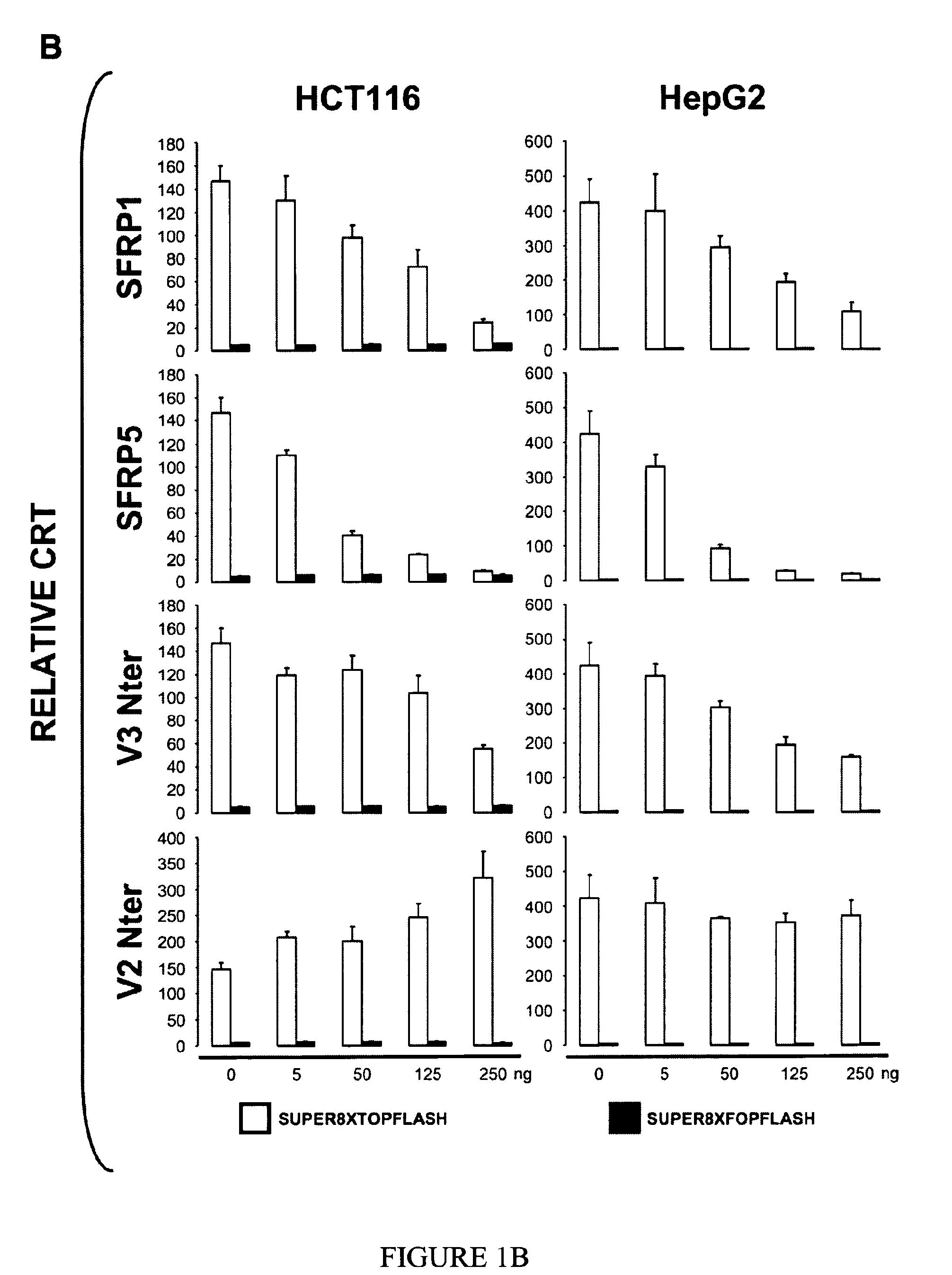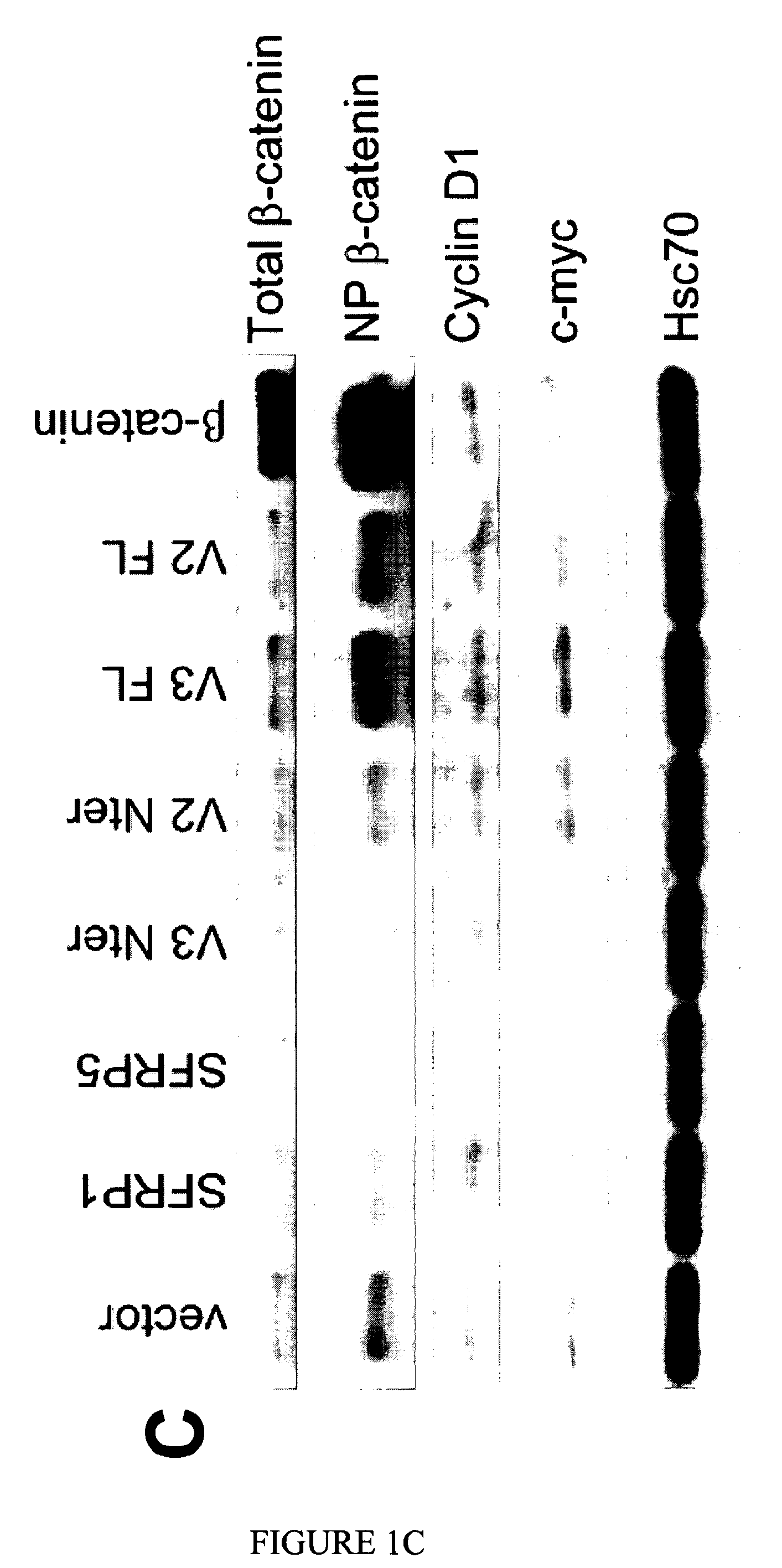Use of FZC18-Containing Collagen 18 Polypeptides for the Treatment, Diagnosis and Outcome Prediction of Diseases
a polypeptide and collagen 18 technology, applied in the field of polypeptides or nucleic acids, can solve the problems of inability to accurately predict the specificity of sfrp family members, impairment of normal liver function, etc., and achieve the effects of suppressing wnt3a-induced crt, inhibiting wnt3a-dependent, and reducing tumor growth ra
- Summary
- Abstract
- Description
- Claims
- Application Information
AI Technical Summary
Benefits of technology
Problems solved by technology
Method used
Image
Examples
example 1
Material and Methods
[0179]Cell Culture, Tissue Samples and mRNA Expression Analysis
[0180]Human CRC cell line HCT116 was cultured in McCoy's 5A plus 10% FCS (Invitrogen). Human HCC cell lines HepG2. Huh-6. Huh-7 (de La Coste et al., 1998), and the mouse HCC cell lines mhAT3F and mhAT3FS315 (Vallet et al., 1995) were cultured as described. HEK 293T and 293EBNA cells were cultured in DMEM (Invitrogen), plus 10% FCS. Human tissue samples and mRNA were obtained as described (Musso et al., 2001a), complying with the guidelines of the National Steering Committee of HCC (INSERM, Paris). Relative mRNA expression was assessed using mRNA arrays hybridized with 32P-labelled cDNAs normalized to 18S under linear-range conditions (Musso et al., 2001a) or by QRT-PCR using SYBR Green PCR Master Mix (Applied Biosystems) and the ABI Prism 7000 (Perkin Elmer). Expression was normalized to 18S and to a calibrator. Primers were designed with Primer 3 on the www. The following primers were used: Forward p...
example 2
Soluble FZC18 Can be Produced for Therapeutic Purposes
[0203]In example 1, we have shown that owl-expression of FZC18 inhibits β-catenin signaling in cells carrying activating β-catenin mutations through autocrine signaling. However, in the physiological setting, tumor cells receive signals from their microenvironment, including cell surface proteins in neighboring cells and soluble factors in the interstitial space. Thus, we prepared clones of FZC18 (+) Human Epithelial Kidney 293T (HEK 293T) cells, a well-characterized cell line capable of secreting glycosylated proteins at high titers (Hsieh et al., 1999), with the aim of confirming that extracellular FZC18 can inhibit β-catenin signaling. Immunostaining with anti-FZC18 and anti-myc tag antibodies confirmed that FZC18 was mainly detected at the cell surface (FIG. 11, A and B). Similar results were obtained after cell fractionation of three FZC18 (+) clones, indicating that FZC18 was only detected in the cell membrane fraction (FIG...
example 3
Use of FZC18, Alone or in Combination with Radiotherapy for Treating Cancer
[0206]V3Nter is more efficient than SFRP1 for suppressing tumor growth. V3Nter-, SFRP1-, V2Nter and VECTOR-HCT116 cell clones were injected subcutaneously into athymic nude mice. Mice were housed under sterile conditions and the appearance of tumors was checked every two or three days by visual inspection and palpation of the injection area. Once palpable tumors were detected, they were measured every two or three days using electronic callipers. Tumor incidence and growth were not significantly different in VECTOR-HCT116 or in V2Nter-HT116 tumors (FIG. 13, B and C). By contrast, V3Nter delayed tumor onset. Indeed, more than 90% of the mice injected with VECTOR-HCT116 or V2Nter-HT116 cells developed a solid tumor by day 13 whereas only 60% of the V3Nter-HCT116 cell-injected mice showed palpable tumors on day 25 (FIG. 13A). Moreover, growth of V3Nter-HCT116 tumors was significantly slower than that of the VECT...
PUM
| Property | Measurement | Unit |
|---|---|---|
| diameter | aaaaa | aaaaa |
| focus-object distance | aaaaa | aaaaa |
| volume | aaaaa | aaaaa |
Abstract
Description
Claims
Application Information
 Login to View More
Login to View More - R&D
- Intellectual Property
- Life Sciences
- Materials
- Tech Scout
- Unparalleled Data Quality
- Higher Quality Content
- 60% Fewer Hallucinations
Browse by: Latest US Patents, China's latest patents, Technical Efficacy Thesaurus, Application Domain, Technology Topic, Popular Technical Reports.
© 2025 PatSnap. All rights reserved.Legal|Privacy policy|Modern Slavery Act Transparency Statement|Sitemap|About US| Contact US: help@patsnap.com



